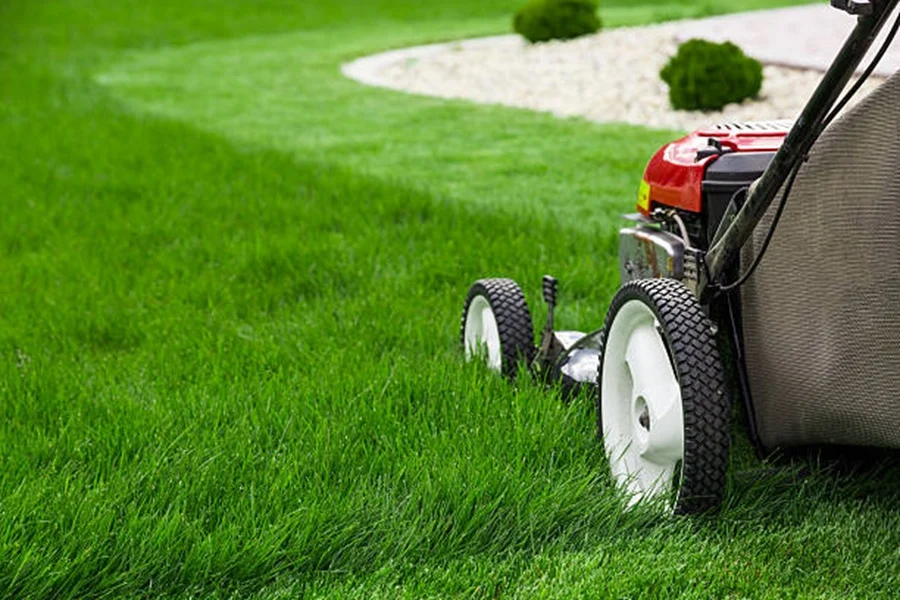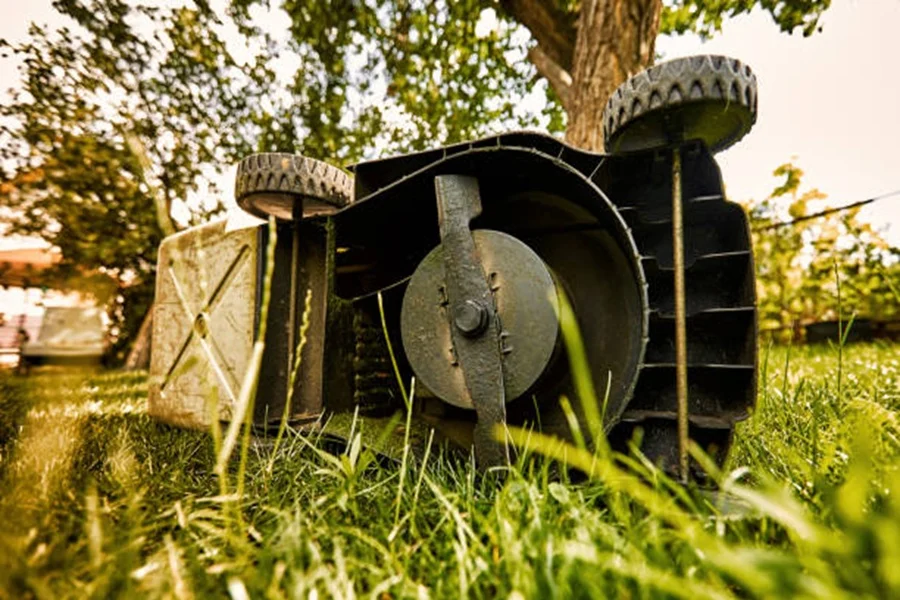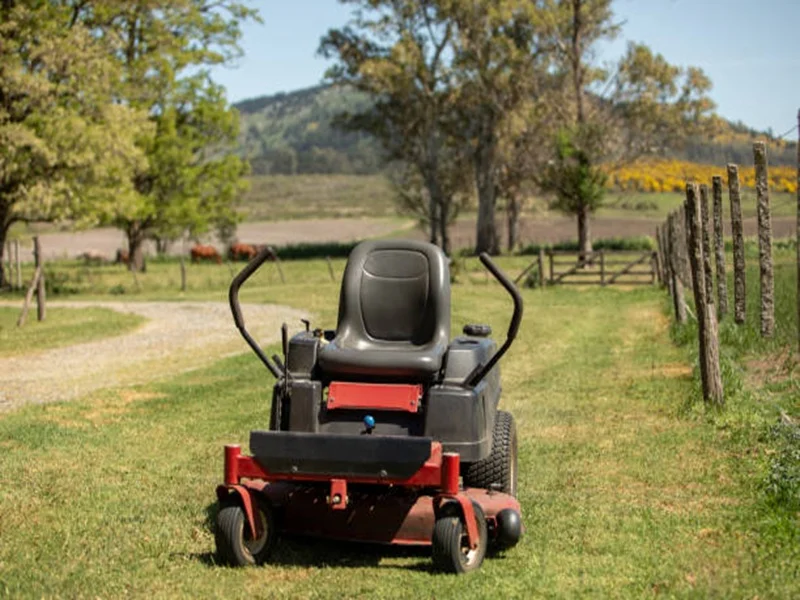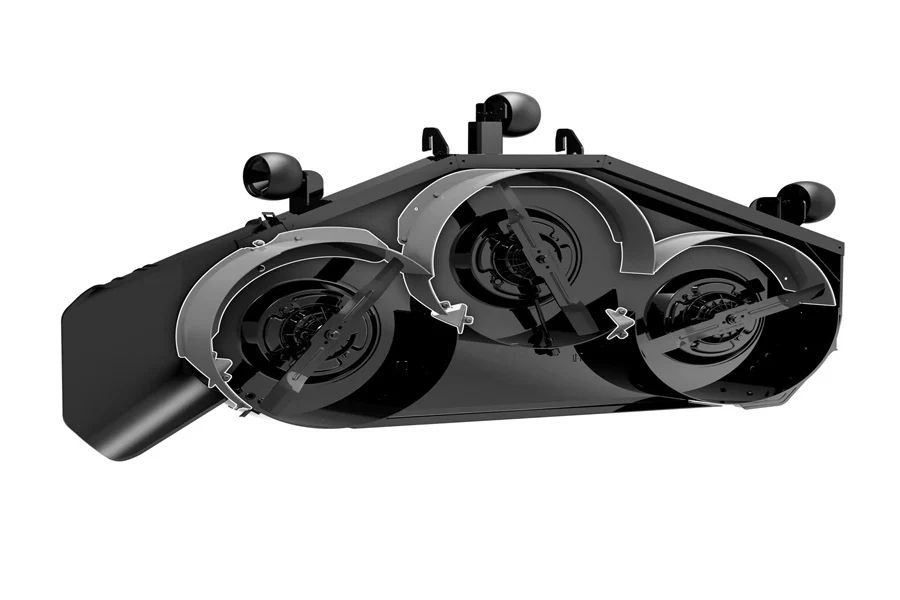THE RIGHT SIZE
Choosing the right size mower is a fundamental step in ensuring that your lawn care routine is efficient, cost-effective, and tailored to your specific needs. The size of the mower directly influences how much time you’ll spend mowing, the quality of the cut, and the overall ease of operation. Here’s a breakdown of the key factors to consider when selecting the appropriate mower size for your property.
Assess Your Lawn Size
- Push Mowers or Reel Mowers: These straightforward options are lightweight, easy to maneuver, and don’t require fuel or electricity. They’re ideal for smaller areas with manageable grass growth.
- Compact Electric Mowers: For added efficiency, compact corded or battery-powered mowers are great for small lawns, especially if they include tight corners or intricate landscaping.
- Self-Propelled Mowers: These take some of the physical effort out of mowing and are designed to cover slightly larger spaces.
- Wider Cutting Deck: Look for options with cutting decks between 20-30 inches to reduce passes without compromising on maneuverability.
- Riding Mowers: If you have significant ground to cover, a riding mower or zero-turn mower offers speed and efficiency without wearing you out.
- Deck Size: Opt for larger cutting decks (over 30 inches) to minimize the number of passes needed.
Consider the Terrain
The physical features of your lawn will also influence the size of mower you need. For example: – For flat, even lawns, almost any mower will suffice, but performance and width considerations will help optimize efficiency. – For hilly or sloped areas, lighter or self-propelled mowers are better suited. Larger riding mowers may struggle on steep inclines due to poor maneuverability. – For landscaping or obstacles, choose smaller, more agile mowers that can navigate around flower beds, trees, and pathways.
Balance Power with Size
While selecting the right size, you’ll also want to ensure the mower has sufficient power for the job: – Electric Models: Compact electric mowers are best for small lawns, but battery life is critical. Check runtime and ensure it can complete the task without interruptions. – Gas Models: These typically provide more power for larger areas but require fuel and maintenance.
Table: Mower Size Recommendations
| Yard Size | Recommended Mower Type | Cutting Deck Width |
| Less than 1/4 acre | Push, Reel, Compact Electric | 14-20 inches |
| 1/4 to 1 acre | Self-Propelled, Electric, Wide | 20-30 inches |
| Over 1 acre | Riding, Zero-Turn | 30+ inches |
Additional Considerations
- Storage Space: A larger mower may perform better for your lawn, but ensure you have adequate storage for it.
- Portability: Smaller mowers are easier to transport, clean, and store, but may not cover ground as quickly.
- Future Needs: If you’re planning to expand your lawn or property, opt for a slightly larger mower to accommodate growth.
Selecting the right size mower ensures that your lawn maintenance is both efficient and sustainable, saving you time and effort while delivering consistent results. Use this as your foundation to make an informed decision, ensuring the mower fits seamlessly into your lawn care routine.
MAINTENANCE CONSIDERATIONS
Purchasing a lawn mower is an investment, and maintaining it properly ensures it will last for years while continuing to perform at its best. Regular upkeep not only prevents unnecessary repairs but also ensures safety and efficiency. Below are the most important aspects to consider regarding mower maintenance.
Understanding Your Mower’s Maintenance Needs
- Gas Mowers: Regular oil changes, spark plug replacements, and air filter cleaning or replacement. Check for fuel system issues such as stale gasoline or clogs in carburetors.
- Electric Mowers: Inspect cords for damage (corded models) or routinely charge and maintain the battery (cordless models). Clean the motor and ensure vents are clear of debris.
- Manual Reel Mowers: Sharpen the blades periodically and check for rust or dirt buildup on moving parts.
Routine Maintenance Checklist
| Task | Frequency | Tools Needed | Type of Mower |
| Blade sharpening | Every 20-25 hours of use | Metal file or grinding tool | All types |
| Oil change | Every 50 hours of operation | Wrench, fresh oil | Gas mowers |
| Battery charging | After each use | Charger compatible with the model | Electric (cordless) |
| Deck cleaning | After every mow | Hose or scraper tool | Gas and electric |
Troubleshooting Common Issues
- Uneven Cuts: Check for dull blades or improperly inflated tires that may affect the mower’s height and cutting performance.
- Starting Issues: If a gas mower doesn’t start, inspect the spark plug, air filter, and fuel quality. Make sure the safety mechanisms aren’t engaged while attempting to start.
- Battery Performance Decline: For cordless models, check the charging connections and replace the battery if it struggles to hold charge even after proper care.
Storage Practices for Reduced Wear
- Seasonal Storage Prep: For gas mowers, run the engine dry to avoid gumming up the carburetor. Remove the battery from electric mowers when not in use for extended periods.
- Indoor Storage: Store your mower in a dry, cool environment, away from direct sunlight and moisture to prevent rust or damage.
Seeking Professional Help
While performing regular maintenance is important, there may be times when professional help is necessary. A qualified technician can inspect areas such as the engine or internal wiring to ensure the mower’s overall health. Scheduling an annual service for your mower can save you from surprises during peak mowing season.
By taking the time to maintain your lawn mower, you’ll enhance its lifespan, improve its performance, and ensure safe, efficient operation throughout its use.
READ THE REVIEWS
When shopping for a mower, one of the most reliable tools to ensure a smart purchase is reading reviews. Both professional and user reviews can provide valuable insights into the performance, durability, and usability of different mower models. Ignoring this step can lead to buyer’s remorse, as you might purchase a mower that doesn’t meet your needs or perform well in your unique environment. Below is a breakdown of why reviews are essential and how to make the most of them.
Understanding Different Types of Reviews
- Professional Reviews
Professional reviews are conducted by experts who rigorously test mowers under various conditions. These reviews often highlight technical specifications, such as engine power, fuel efficiency, and cutting width, and compare models within the same class (e.g., gas-powered vs. electric mowers). They are especially useful for understanding how a mower might perform over time.
Example sources for professional reviews:
– Trusted industry websites
– Consumer watchdog organizations
– Equipment review blogs
- User Reviews
User reviews, on the other hand, come from individuals who’ve purchased and used the mower. These reviews give you a real-world perspective on what to expect. Look for trends in user feedback, especially regarding reliability, ease of use, and possible issues.
When reading user reviews:
– Focus on models with a high number of reviews to get a balanced perspective.
– Take note of repeated positives or negatives, which are likely accurate.
– Disregard single outlier complaints unless they align with broader concerns.
What to Look for in Reviews
- Cutting power and ability to handle tall or thick grass.
- Results on uneven terrain or wet conditions.
- Durability of blades, handles, and engines.
- Material quality, such as steel decks versus plastic.
- Feedback on how often the mower needs tune-ups or repairs.
- Access to replacement parts and servicing.
- Effort required to maneuver the mower.
- Noise levels and vibration impact.
- Features like self-propulsion, mulching, and bagging.
- Warranty offerings and ease of contacting customer service.
- Responsiveness to unresolved issues.
Tips for Spotting Reliable Reviews
- Verified Purchases
Always check for reviews labeled as “verified purchase” when possible, as these are less likely to be fake or biased. - Balanced Feedback Over Extremes
Be cautious of overly glowing or wholly negative reviews with little detail. Balanced reviews that address both pros and cons are generally more trustworthy. - Recent Reviews
Look for reviews posted in the last 12 months to ensure relevance, as older reviews might not reflect recent updates or changes in product quality.
Limitations of Reviews
While reviews are valuable, they shouldn’t be your sole decision-making tool. People have varying preferences and different lawn types, which might result in conflicting opinions. Reviews are best used as a guide, paired with additional steps like hands-on demonstrations or consulting with sales representatives.
Taking the time to explore a wide range of reviews will ultimately help you find a mower that aligns with your lawn care needs and budget.
READ THE REVIEWS
Why Reviews Matter
Reviews serve as a reality check against the manufacturer’s claims. Advertisements and product descriptions tend to highlight only the positives, but reviews give you a clearer picture of the product’s everyday performance. They often discuss real-world scenarios, such as:
– Ease of operation on different types of terrain.
– Actual fuel consumption rates or battery life.
– Noise levels during use.
– Common issues or defects reported by buyers.
Where to Look for Reviews
With so many platforms available, it’s crucial to know where to find reliable information. Consider the following resources:
– Manufacturer’s website: Look for reviews on the official site, keeping in mind that these may be curated or filtered.
– Retailer websites: Platforms like Amazon, Home Depot, and Lowe’s often feature customer reviews with detailed ratings.
– Independent review sites: Websites such as Wirecutter or Consumer Reports offer unbiased testing and recommendations.
– Forums and social media: Enthusiast or homeowner forums like Reddit, as well as Facebook groups, often provide unfiltered peer-to-peer advice.
– Video reviews: YouTube channels by lawn care enthusiasts may demonstrate how different mowers perform in action and share opinions on various models.
Tips for Evaluating Reviews
While reviews are helpful, it’s important to analyze their reliability carefully. Not all reviews are created equal, and understanding how to evaluate them will help you avoid misplaced trust.
– Look for detailed reviews that discuss specific features, such as blade quality, cutting width, or handling. These are more useful than vague expressions like “great mower.”
– Check for consistency among multiple reviews—if many buyers mention a common issue (e.g., the handle breaking or uneven cutting results), it may indicate a legitimate fault.
– Balance pros and cons within each review to gauge whether the benefit of a mower outweighs any concerns.
An Example of a Review Table
| Model | Durability | Ease of Use | Noise Level | Consumer Rating |
| Model A | High | Moderate | Low | 4.2/5 |
| Model B | Moderate | High | Moderate | 4.7/5 |
| Model C | Low | High | Low | 3.8/5 |
Red Flags to Watch For
When scouring reviews, pay attention to possible warning signs:
– An overwhelming number of 5-star or 1-star reviews without context may indicate manipulated ratings.
– Review phrases like “just got this yesterday, and it’s amazing” may lack credibility since the reviewer hasn’t used the product long enough to test durability.
– A lack of reviews for a specific brand or model may indicate a newer model with an unproven track record.
By dedicating time to extensive review research, you’ll gain confidence in selecting a mower that aligns with your needs, ensuring both satisfaction and long-term value.
STORAGE
When purchasing a lawn mower, proper storage is a critical consideration that directly affects its performance, durability, and lifespan. Storing your mower incorrectly can lead to engine damage, rust, or other structural problems. Whether you are a first-time buyer or replacing an old mower, deciding where and how to store it should be part of your buying process. Below are helpful insights on this topic to ensure your investment stays in top shape for years to come.
Why Storage Matters
The way you store your mower influences: – Durability: Exposure to the elements, like water, snow, or direct sunlight, can cause rust or fade plastic parts. – Engine Health: Leaving a mower outdoors without protection increases the risk of moisture entering the engine, leading to corrosion or difficulty starting the machine. – Safety: Proper storage enhances safety by minimizing tripping hazards or accidents when the mower isn’t in use.
Types of Storage Spaces
| Type of Space | Important Considerations |
| Garage/Workshop | Ideal for most mowers, offers protection from weather and theft |
| Garden Shed | Provides ample space but ensure it’s dry and ventilated |
| Outdoor Storage Covers | Works for smaller areas; invest in weather-resistant covers |
| Vertical Storage Racks | Suitable for compact or foldable mowers to save floor space |
Features to Look for in a Storage-Friendly Mower
Certain mower designs make storage easier. If you’re limited on space, prioritize these features when shopping: – Foldable or Collapsible Handles: Allows the mower to fit into tight spaces, such as shelves or small corners.
– Vertical Storage Capability: Some advanced mowers are designed to stand upright, saving floor space.
– Compact Designs: Electric or battery-powered mowers generally take up less storage space than gas-powered models.
Storage Tips for Longevity
Once you’ve selected your lawn mower, follow these storage best practices to ensure it stays functional: – Clean Before Storage: Always remove debris or clippings from the blades and underside to prevent rust or pest infestations.
– Drain Fuel for Long-Term Storage: If you’re storing the mower for the winter, empty the fuel tank to avoid engine clogging.
– Use a Protective Cover: Even indoors, a cover prevents dust and moisture buildup.
– Store in a Dry Location: Avoid damp basements or areas prone to flooding, as moisture accelerates rusting.
Questions to Ask Yourself about Storage
Before finalizing your mower purchase, ask these questions to ensure you’ve accounted for storage needs: – Do I have enough indoor space, or will I need an alternative like a weatherproof cover?
– Can the mower I’m considering fold or store vertically to fit my available space?
– If I’m storing it outdoors, do I have an area that is off the ground and safely covered?
By planning for storage ahead of time, you’ll not only protect your mower but also get the best return on your investment over time.
STORAGE
Proper storage of your lawn mower is critical for ensuring its longevity, performance, and safety. Whether you use your mower daily during peak mowing seasons or only occasionally, knowing how and where to store it properly can help you avoid costly repairs, unsafe handling, or reduced efficiency over time. Below, we discuss some effective storage strategies to keep your mower in top-notch condition.
Choose the Right Storage Location
When deciding where to store your lawn mower, consider the following factors:
– Protection from Elements: Always store your mower in a dry, covered space, such as a garage or shed, to safeguard it from rain, snow, and extreme sunlight. Prolonged exposure to weather can cause rust, corrosion, or faded finishes.
– Temperature Control: Avoid storage in areas subject to extreme cold or heat, as fluctuating temperatures can affect engine fluids and battery life if your mower is electric or battery-powered.
– Ventilation: Ensure the storage area has sufficient airflow. Gasoline fumes from stored fuel mowers or excess moisture can create hazardous conditions.
Prep Before Long-Term Storage
For seasons when the mower will not be in use, such as winter, proper preparation is necessary to keep the machine in working order.
1. Clean Thoroughly:
– Remove any grass clippings and debris from the mower’s deck, blades, and air filters to avoid clogging or mold growth.
– Pay attention to areas where dirt might accumulate and corrode parts over time.
- Empty the Fuel Tank (For Gasoline-Powered Models):
- If you’re storing the mower for more than 30 days, drain the fuel tank or add a fuel stabilizer to prevent fuel degradation, which can damage the carburetor.
- For electric mowers, detach the battery and store it separately in a cool, safe place to maintain battery health.
- Sharpen the blades if dull, and check the engine for leaks or wear. Regular inspection before storage reduces minor issues escalating into major repair jobs.
- Apply oil to the engine as per the manufacturer’s instructions and lubricate any moving parts to prevent rusting.
Organize for Easy Access
Storing your mower in an organized manner ensures it’s easy to retrieve when needed:
– Use a mower cover to shield it from dust and accidental spills in the storage area.
– Keep it on a flat, level surface to avoid tipping or damage.
– Store accessories or related items, such as fuel cans, spare parts, and grass collection bags, close by for convenience. Creating a designated area avoids misplacement of critical components.
Storage Tips for Smaller Spaces
- Foldable Handle Mowers: Many modern mowers feature collapsible handles to minimize space. This feature is particularly handy for those with limited storage areas.
- Wall-Mounting Options: Electric or lightweight mowers can often be stored upright or wall-mounted with proper brackets for compact storage.
- Vertical Storage Models: Some newer designs enable vertical storage while ensuring no oil or gas leakage, making them ideal for small garages or sheds.
Seasonal Inspections
If your mower is stored for months at a time, conduct routine checks during its downtime. This includes inspecting for leaks, rust, or any rodent damage to wiring or belts. Early identification can save both time and money when reactivating your equipment for the next mowing season.
By prioritizing effective storage practices, you protect the lifespan and performance of your lawn mower while maintaining safety and efficiency throughout its use.
STORAGE
Proper storage of a lawn mower is essential to maintain its longevity, performance, and safety. Whether you’re buying your first mower or upgrading, understanding storage requirements can help you extend the lifespan of your machine and keep it in prime condition. In this section, we’ll explore practical tips and considerations to help you store your mower effectively.
Factors to Consider for Mower Storage
- Space Availability
Assess the space you have available for storing your mower. Whether you’re working with a garage, shed, or storage unit, ensure there’s enough room to accommodate the size of the mower. Avoid overly cramped conditions that might lead to accidental damage. - Climate and Weather Protection
Extreme temperatures and moisture are primary factors in mower wear and tear. Choose storage solutions that protect the mower from rain, snow, excessive sunlight, and humidity, which can cause rust and degradation over time. - Accessibility
Place the mower in a location that is convenient to access when it’s needed. For example, avoid storing it behind heavy or bulky items in tight spaces. Seasonal use may require frequent access, so think about ease of retrieval.
Steps for Proper Mower Storage
- Clean the Mower Thoroughly
Remove grass clippings, dirt, and debris from your mower. Pay special attention to the underside of the mower deck to prevent buildup that can contribute to corrosion. - Drain or Stabilize Fuel
If storing the mower for more than 30 days, either drain the fuel tank or add a fuel stabilizer. This prevents the fuel from degrading and clogging the carburetor. - Check and Maintain Oil Levels
Inspect oil levels and change the oil if needed. Storing a mower with clean oil helps avoid engine damage from contaminants during inactivity. - Disconnect the Battery (For Electric or Gas Mowers with Batteries)
To preserve the life of the battery and prevent accidental power drain, disconnect it and store it indoors in a cool, dry place. - Inspect and Protect Blades
Inspect the mower blades and sharpen them if necessary. Apply a thin layer of lubricant to prevent rust. - Cover the Mower
Use a durable, weather-resistant cover to shield your mower from dust, moisture, and pests. Ensure the cover allows for some airflow to avoid trapping condensation.
Storage Solutions for Different Mowers
| Type of Mower | Recommended Storage |
| Push Mowers | Compact and easy to store in a shed or garage. Consider hanging on a wall for space efficiency. |
| Riding Lawn Mowers | Require larger space; use a dedicated area in a garage or shed. Consider wheel locks for added safety. |
| Electric/Battery Mowers | Store indoors to protect from exposure to extreme weather, especially for batteries. |
Long-Term vs. Short-Term Storage
- Short-Term Storage
After everyday use, ensure the mower is clean and parked on a flat surface in a safe location. For gas-powered mowers, close the fuel valve (if applicable). - Long-Term Storage
When preparing for seasonal storage, follow the full preparation steps mentioned above. Consider periodic checks, especially for battery-operated models, to ensure components remain in good condition.
Effective storage is key to preserving the functionality and value of your mower. By taking the time to protect your equipment, you not only avoid unexpected maintenance costs but also ensure that it’s ready to perform when the next mowing season arrives.





